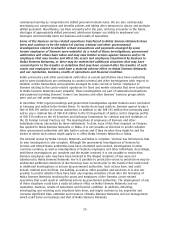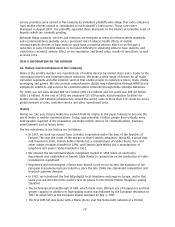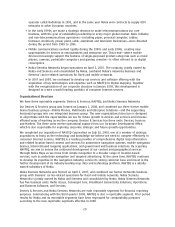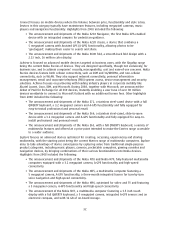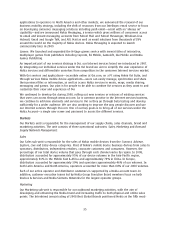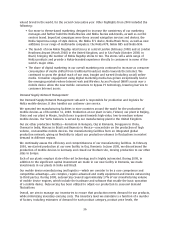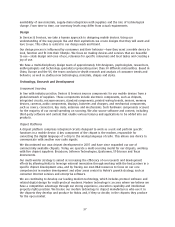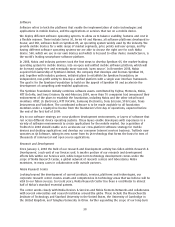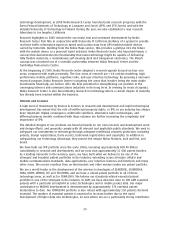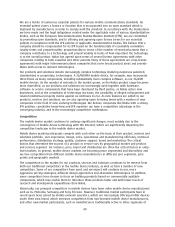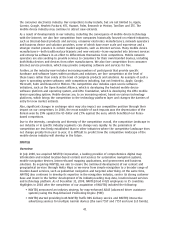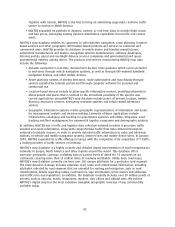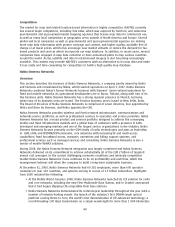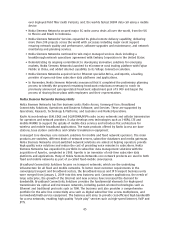Nokia 2008 Annual Report Download - page 37
Download and view the complete annual report
Please find page 37 of the 2008 Nokia annual report below. You can navigate through the pages in the report by either clicking on the pages listed below, or by using the keyword search tool below to find specific information within the annual report.valued brand in the world, for the second consecutive year. Other highlights from 2008 included the
following:
• Our move to themebased marketing, designed to increase the consistency of our marketing
messages and further build the Nokia Nseries and Nokia Eseries subbrands, as well as our Ovi
services brand. Important campaigns were those around navigation services and devices, the
Nokia Supernova range of style devices, the Nokia E71 device, Nokia Music Store, as well as new
additions to our range of multimedia computers: the Nokia N79, Nokia N85 and Nokia N96.
• The launch of new Nokia flagship retail stores in central London (February 2008) and at London
Heathrow Airport (March 2008) in the United Kingdom, and in Sa
˜o Paulo (October 2008) in
Brazil, bringing the number of Nokia flagship stores to ten. The stores sell a wide range of
Nokia products and provide a Nokiabranded experience directly to consumers in some of the
world’s major cities.
• The share of digital marketing in our overall marketing mix continued to increase as consumer
consumption of media shifted from traditional broadcast media towards the Internet. We
continued to grow the global reach of our own, bought and earned (including social) online
media. Consumer engagement using digital marketing media has grown exceptionally fast in
the emerging markets where Internet web and Wireless Access Protocol (WAP) access over a
mobile device allow the new mobile consumers to bypass PC technology, lowering barriers to
consumer Internet access.
Demand Supply Network Management
Our Demand Supply Network Management subunit is responsible for production and logistics for
Nokia mobile devices. It also handles our customer care service.
We operated ten manufacturing facilities in nine countries around the world for the production of
mobile devices as of December 31, 2008. Production at our plant in Salo, Finland, our plant in Beijing,
China and our plant in Masan, South Korea is geared towards highvalue, lowtomedium volume
mobile devices. Our Vertu business is served by our manufacturing plant in the United Kingdom.
Our six other production facilities—Komárom in Hungary, Cluj in Romania, Dongguan in China,
Chennai in India, Manaus in Brazil and Reynosa in Mexico—concentrate on the production of high
volume, costsensitive mobile devices. Our manufacturing facilities form an integrated global
production network, giving us flexibility to adjust our production volumes to fluctuations in market
demand in different regions.
We continually assess the efficiency and competitiveness of our manufacturing facilities. In February
2008, we started production at our new facility in Cluj, Romania. In June 2008, we discontinued the
production of mobile devices in Germany and closed our Bochum site, moving production to our other
sites in Europe.
Each of our plants employs stateoftheart technology and is highly automated. During 2008, in
addition to the significant capital investment we made in our new facility in Romania, we made
investments in our plants in India and Brazil.
Our mobile device manufacturing and logistics—which we consider to be a core competence and
competitive advantage—are complex, require advanced and costly equipment and involve outsourcing
to third parties. During 2008, outsourcing covered approximately 17% of our manufacturing volume
of mobile device engines, which include the hardware and software that enable the basic operation
of a mobile device. Outsourcing has been utilized to adjust our production to seasonal demand
fluctuations.
Overall, we aim to manage our inventories to ensure that production meets demand for our products,
while minimizing inventorycarrying costs. The inventory level we maintain is a function of a number
of factors, including estimates of demand for each product category, product price levels, the
36


